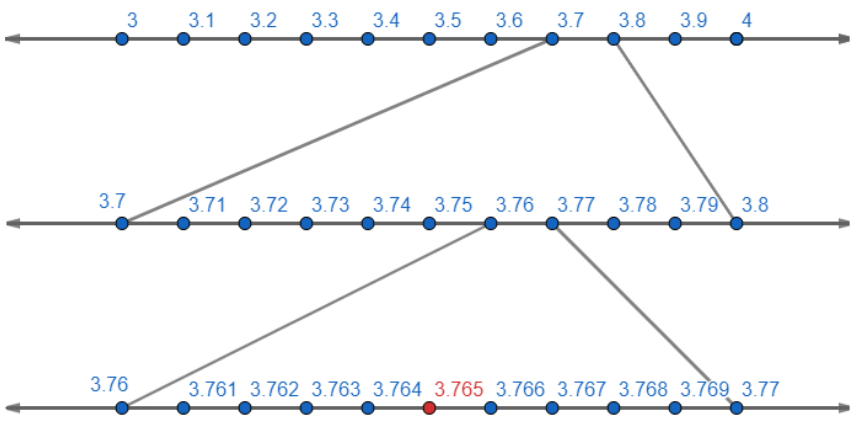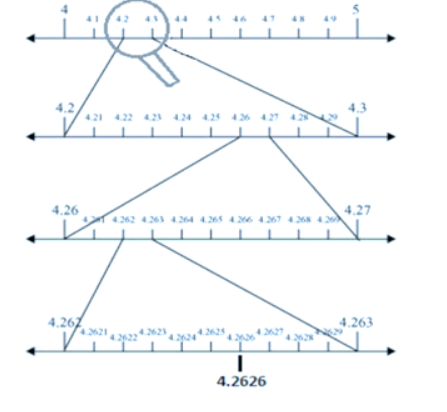NCERT Solutions for Exercise 1.4 Class 9 Maths Chapter 1 - Number Systems
NCERT Solutions for Class 9 Maths Exercise 1.4 Chapter 1 Number Systems- Download Free PDF
NCERT Solutions Class 9 Maths Chapter 1 Number Systems Exercise 1.4- The notion of the position of real numbers is covered in NCERT Solutions for Class 9 Maths exercise 1.4 which includes both terminating and non-terminating recurring decimal expansions on the number line. In mathematics, rational numbers, irrational numbers, natural numbers, whole numbers, integers, and real numbers are split into numerous groups.
Real numbers are combinations of rational and irrational numbers, as shown in exercise 1.4 Class 9 Maths. A rational number is nothing but a number that can be stated as a fraction in the form p/q where p and q are integers and q≠0. An irrational number is one that cannot be represented as a fraction with an integer numerator and denominator. NCERT Solutions for Class 9 Maths Chapter 1 Exercise 1.4 consists of two questions based on the decimal representation given in a string of numbers. Horizontal lines with evenly spaced integers are called number lines. The concept of numbering is well explained in this exercise Class 9 Maths Chapter 1 exercise 1.4. The following exercises are also presented here along with Class 9 Maths chapter 1 exercise 1.4.
The class 9 maths ex 1.4 solutions are meticulously crafted by subject matter experts at Careers360. These solutions are presented in a detailed and easy-to-understand language, ensuring that students can grasp the concepts effectively. Additionally, these exercise 1.4 class 9 maths solutions are available in PDF format, offering the convenience of offline access and easy reference for students. Careers360's commitment to providing comprehensive and accessible solutions can be immensely helpful for students studying Class 9 Maths.
NCERT Solutions for Class 9 Maths Chapter 1 – Number Systems Exercise 1.4
Access Number Systems Class 9 Chapter 1 Exercise: 1.1
Q1 Visualise 3.765 on the number line, using successive magnification.
Answer:
3.765 can be visualised as in the following steps.
First, we draw a number line and mark points on it after that we will divide the number line between points 3 and 4. And then we will divide the points between 3.7 and 3.8 as the number is between both of them.

Q2 Visualise $4.\overline{26}$ on the number line, up to 4 decimal places.
Answer:
We can rewrite $4.\overline{26}$ as
$\Rightarrow 4.\overline{26}= 4.262626...$
Now, 4.2626 can be visualised as in the following steps.

More About NCERT Solutions for Class 9 Maths Exercise 1.4:
The concept of representing a decimal number on the number line was the emphasis of the NCERT book Class 9 Maths exercise 1.4. The representation of decimal numbers on the number line is the sole focus of NCERT syllabus exercise 1.4 Class 9 Maths. Decimal numbers are fractional numbers expressed in a particular form that is divided into Recurring Decimal Numbers (Non-Repeating or Terminating Decimals) and Non-Recurring Decimal Numbers (Non-Repeating or Terminating Decimals).
Also Read| Number Systems Class 9 Notes
Benefits of NCERT Solutions for Class 9 Maths Exercise 1.4:
• NCERT solutions for Class 9 Maths exercise 1.4 helps us to portray the decimal numbers on the number line as per the given instructions.
• We will learn how to represent real numbers on the number line by answering the NCERT solution for Class 9 Maths chapter 1 exercise 1.4 exercises.
•In exercise 1.4 Class 9 Maths, we may get a chance to think through the number system logic to derive the answer.
Key Features of Class 9 Maths Chapter 1 Exercise 1.4
Expertly Crafted Solutions: The 9th class maths exercise 1.4 answers are created by subject matter experts, ensuring accuracy and clarity in explanations.
Detailed Explanations: Each ex 1.4 class 9 solution is accompanied by a detailed explanation to help students understand the concepts and problem-solving techniques.
Step-by-Step Format: class 9 maths ex 1.4 Solutions are presented in a step-by-step format, making it easy for students to follow the solution process.
PDF Availability: Exercise 1.4 class 9 maths Solutions are often available in PDF format, which allows students to download and access them offline for convenient studying.
Concept Clarity: Class 9 ex 1.4 focuses on reinforcing the understanding of fundamental mathematical concepts related to real numbers and their properties.
Syllabus Alignment: Class 9 Maths Chapter 1 exercise 1.4 aligns with the prescribed syllabus, covering all relevant topics and concepts.
Accessible Learning: The 9th class maths exercise 1.4 answers aim to make learning accessible and comprehensible for all students, regardless of their skill level.
Self-Study Support: Students can use these solutions for self-study, helping them learn and revise at their own pace.
Also see-
NCERT Solutions of Class 10 Subject Wise
Subject Wise NCERT Exemplar Solutions
Frequently Asked Questions (FAQs)
-6 is greater than -13. Since we go towards the left on a number line the magnitude of the number increases but due to its negative sign, -6 is greater than -13.
Yes, 0.054 is a non-recurring decimal number. Since 0.054 is a non Repeating and Terminating number.
On dividing 1 by 2, we get 0.5
Thus the decimal representation of 1/2 is 0.5
Yes, the given statement is true. On the number line, Between any two rational numbers, there are infinitely many rational numbers.
All-natural numbers, whole numbers, integers, rational numbers, and irrational numbers can be represented on the number line, according to NCERT solutions for Class 9 Maths chapter 1 exercise 1.4.
There are two questions in the NCERT solutions for Class 9 Maths chapter 1 exercise 1.4, and the questions are based on the concept of the position of real numbers, both with terminating decimal expansions and non-terminating recurring decimal expansions on the number line.
Option (d) Negative – 0 – positive
Reason: Mathematically, 0 is the middle point of a number line and all positive numbers occupy the right side of the zero whereas the left side of zero was occupied by the negative numbers on the number line.
-14/7=-2
It lies on the left side since the left side of zero was occupied by the negative numbers on the number line.
Popular Questions
Courses After 12th
Applications for Admissions are open.
As per latest syllabus. Physics formulas, equations, & laws of class 11 & 12th chapters
JEE Main Important Chemistry formulas
Get nowAs per latest syllabus. Chemistry formulas, equations, & laws of class 11 & 12th chapters
JEE Main high scoring chapters and topics
Get nowAs per latest 2024 syllabus. Study 40% syllabus and score upto 100% marks in JEE
JEE Main Important Mathematics Formulas
Get nowAs per latest syllabus. Maths formulas, equations, & theorems of class 11 & 12th chapters
